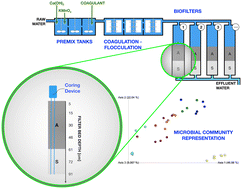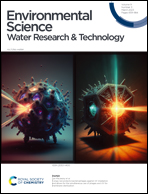Microbiome and hydraulic performance changes of drinking water biofilters during disruptive events-media replacement, lake diatom bloom, and chlorination†
Abstract
Little is known about microbial community, filter media characteristics and hydraulic performance changes during disruptive events in biofilters. For the first time, a series of core samplings through the filter media depth was conducted over two years to study microbiome and filter media attributes along with the hydraulic performance indicators to understand the changes and their interrelations. These samples covered baseline and disruptive events, including filter media replacement, a lake diatom bloom, and chlorination resolving the performance challenges caused by the bloom. Based on 16S rRNA gene sequencing, the ecological indices were correlated against the hydraulic performance indicator, such as filter runtime, head-loss and filter media parameters (e.g., deposited metals, biological activity, and turbidity). Hydraulic performance declined during the disruptive events reflected in the microbiome community structure as well as the biological activity of the biofilter. As expected, the highest ATP and head-loss accumulation rates were observed during the lake diatom bloom. The fresh media samples, the media replacement event, showed a distinct microbiome, as indicated by beta diversity and confirmed by PERMANOVA statistical analysis. However, the chlorination did not shift the microbial community structure compared to that of the diatom bloom. This could be because chlorination may have pushed the microbes to the lower levels or the fact that 16S rRNA sequencing does not distinguish between dead and live cells. Based on the findings of this study, replacing filter media showed a more noticeable shift in the microbial community than diatom bloom and the subsequent chlorination. A significant correlation was observed between FRT, deposited aluminum concentration, and turbidity accumulation rate on the filter media. Biological activity, as measured by adenosine triphosphate (ATP), and turbidity decreased as filter depth increased. No significant variation in alpha diversity indices such as richness, Shannon and evenness through the biofilter's depth was observed. In contrast, beta diversity indicated changes in microbial community structure through the depth of the biofilter. It is concluded that the impact of the disruptive events does not end with the hydraulic performance indicators but rather extends to the microbial community structure and diversity. The findings may contribute to further predicting performance changes in case of deviation from baselines in different water utilities.



 Please wait while we load your content...
Please wait while we load your content...